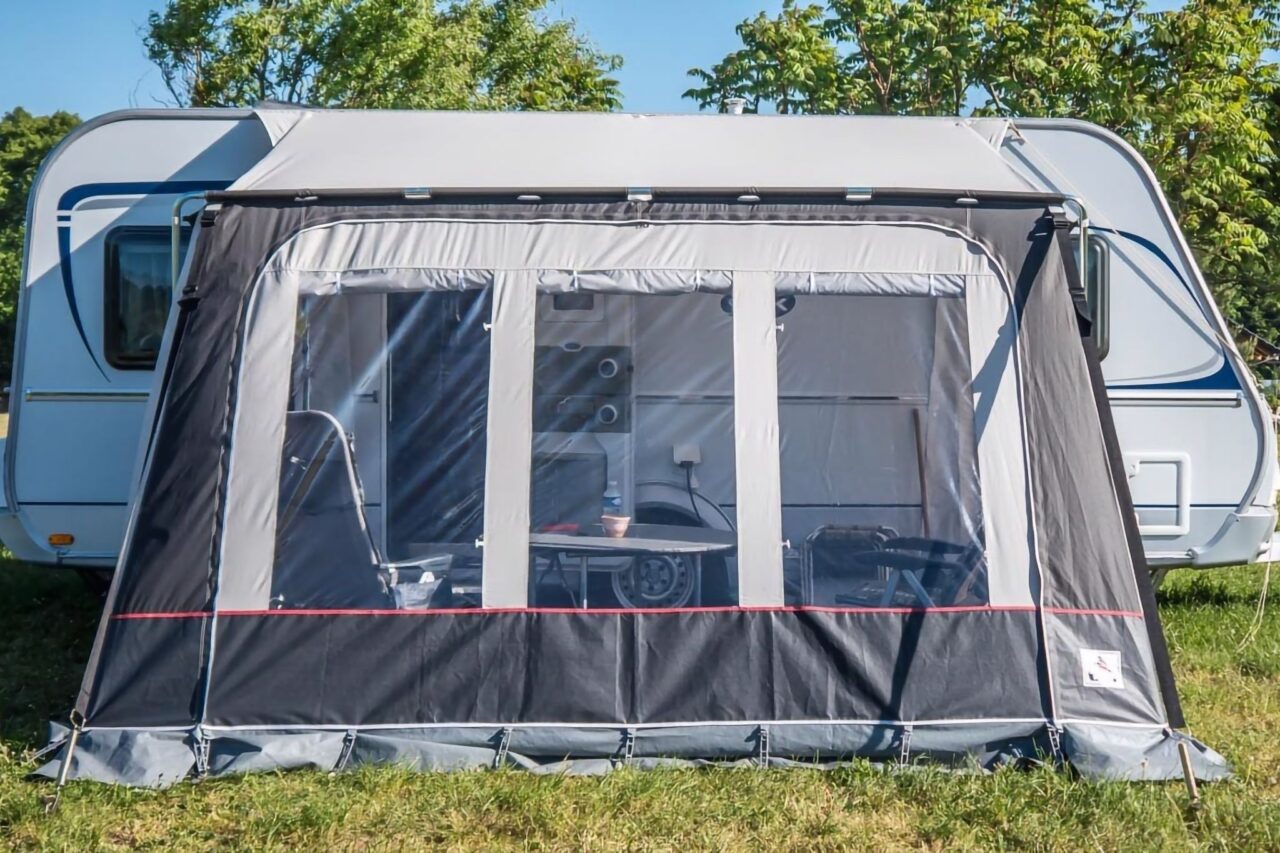Have you ever sprinted out of the camper in the middle of the night to retract the awning? Or – even worse – has your awning been ripped out of its moorings during a storm? Unfortunately, this is an experience shared by many a camping enthusiast.
Fortunately, there are good solutions for sleeping in peace even in wind and weather. Here you can find out which accessories are useful and which storm protection is available for awnings and awnings.
Inhaltsverzeichnis
- Quick video guide: Secure awning or awning with screw pegs and storm straps
- Tensioning the awning correctly
- The right storm protection for your awning
- Set up and tension the awning correctly
- Secure awning against storms
- Not all herring are the same
- Safety first
- Avoid tripping hazards
- Tool and accessory tips
Quick video guide: Secure awning or awning with screw pegs and storm straps
In this video, Nele briefly shows you how to secure your awning or awning so that it can withstand minor gusts or storms. You will find detailed explanations further down in the text:
Tensioning the awning correctly
Basically, everything starts with the correct assembly. A look at the assembly instructions will prevent unnecessary frustration. It also helps to set up the tent in peace and quiet before your vacation, especially if it is new or you haven’t used it for a while.
It may also be helpful to take photos and mark the poles. That way, you can be sure that everything is complete when you are on vacation.
Before setting up, take another good look at the site and clear away any stones or branches lying around. If possible, it is best to position yourself so that the tent and especially the entrance are not directly facing the weather.
Tip
Important: Assembly always starts from the vehicle! It’s best to have everything you need ready beforehand (see below for tips on tools). If your tent has individual front and side walls, leave these in place for now – they will only be attached later.
The frame is assembled first. When everything is in place, first pull in the front wall and then the side walls. Make sure that the seams run exactly parallel to the gable pole and the corner poles.
Now close all the zippers and take another look at the whole thing. Are the zippers straight vertically and horizontally? Is the center angle in the middle as it should be? Are the tent skins pulled smooth?
In the next step, it is important to tension the poles correctly so that the tent skin is taut. Smooth tent surfaces offer the wind less surface to attack. When tensioning, make sure that the gable seam does not sit directly on the gable pole, but in front of it.
In contrast, align the other poles so that the seams lie exactly on the poles. Secure the corners of the tent and the guy lines with pegs and the ends of the zippers with pegs. Also remember to fit the scuff guard to the clamps. It prevents the tent skin from being damaged.
The right storm protection for your awning
With good storm equipment, you can secure your awning properly in bad weather. It is best to buy several storm straps for awnings (also known as “tie downs” ), which are often available in matching sets.
- Verhindert das Hochwehen von Markise und Schutzzelt! Hierdurch ist Ihre Markise perfekt gesichert!
- Lieferumfang: 2 stabile Gurte je ca. 3,0 m, Schwerlastheringe, Befestigungsteile, Tasche zur…
Now you need to attach the storm strap correctly. This also depends on the choice of pegs (see below). Storm straps are usually made of durable, wide webbing material and have a firm locking mechanism that cannot come loose on its own. This makes them significantly more resilient than simple guy ropes, which are normally supplied as accessories.
I can only advise you not to be careless here, but to use all the anchor points. It is also important to close the awning completely so that the wind cannot blow under or into the tent.
There are also special storm straps for storm protection of awnings , which are additionally placed and stretched over the tent. However, these may strain the tent skin as the constant movement in the wind can cause friction.
Additional abrasion protection is recommended here. Incidentally, some camping professionals recommend twisting the storm straps that are placed over the awning roof – this should prevent annoying “banging” at night.
In any case, you should follow the manufacturer’s instructions carefully. Isabella, for example, recommends NOT tightening the storm straps completely so that they only prevent the awning from being lifted if necessary, but are not constantly under tension.
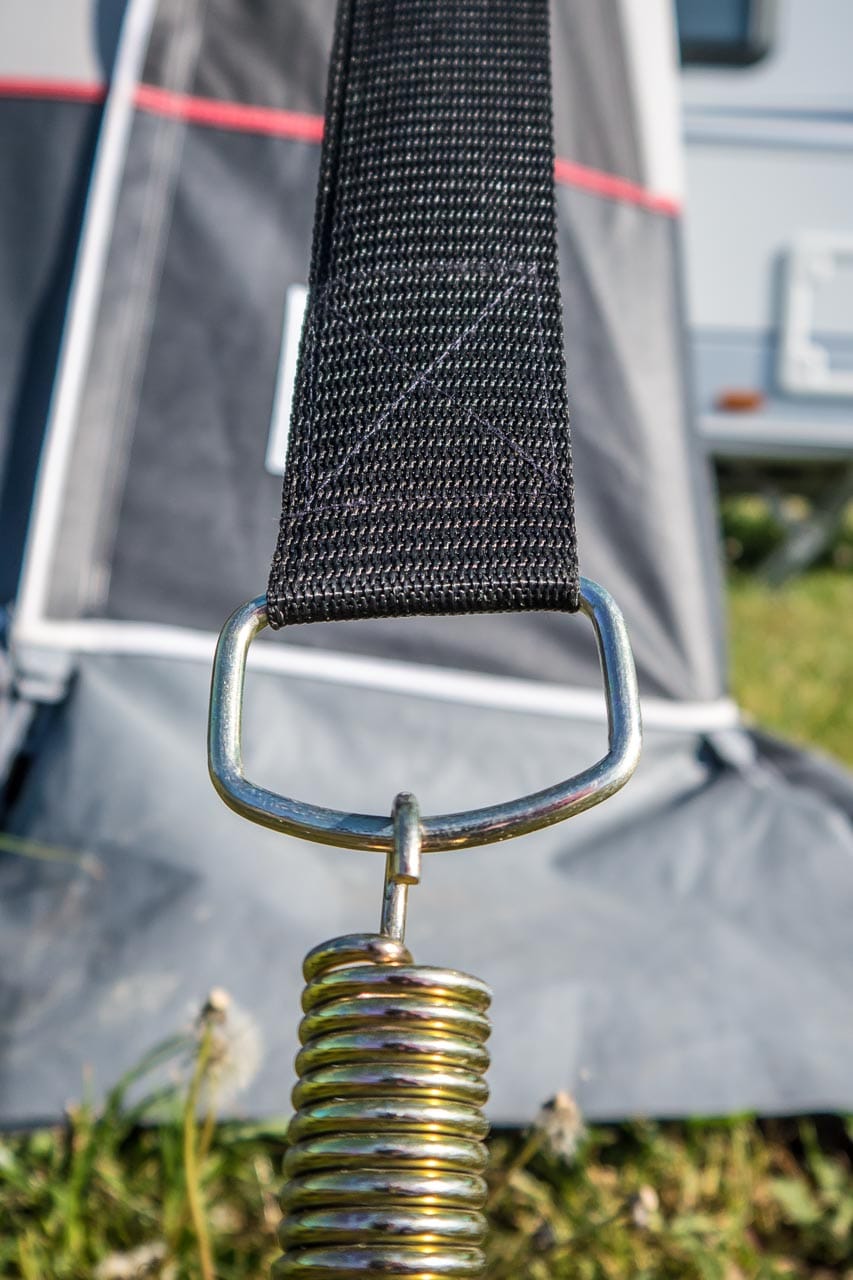
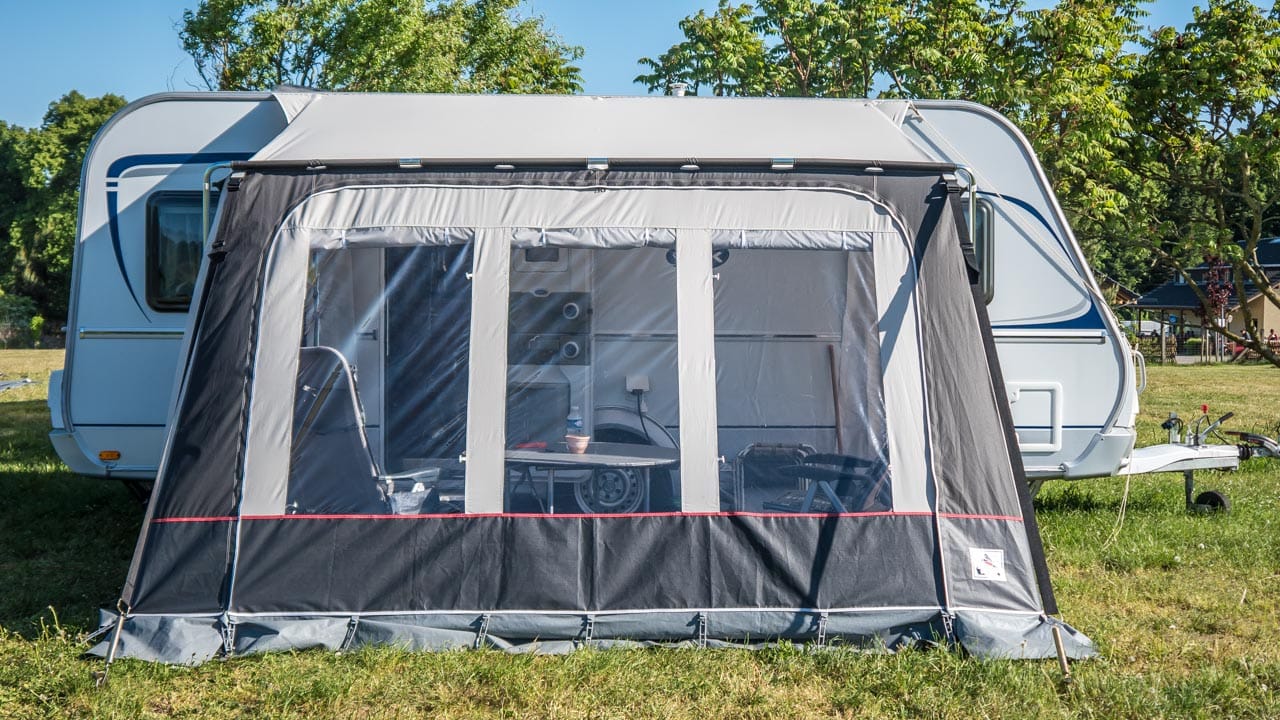
Set up and tension the awning correctly
Free-floating or with support legs, hook-in or fixed, electric or with a hand crank: the choice of awnings is huge. Awnings that are not permanently stowed in a cassette are best threaded into the piping rail from the bow and slowly pushed forward.
Then insert the poles into the bracket. Adjust the supports so that the awning has a slight slope away from the vehicle and to one side so that rainwater can run off!
Once everything is in place and the roof is tensioned, you can attach the side walls – if available – and tension the awning. The following applies here: It is better to gradually apply more tension to the tensioning system in order to achieve even tension distribution.
As a general rule, an awning with support legs or a gazebo should always be secured with guy ropes if you let it out of your sight. Make sure to brace the supports to the front as well, not just to the side. This is the only way to prevent the awning from being lifted up and damaged by the wind.
Secure awning against storms
As with awnings, it is advisable to secure the awning with storm straps in windy conditions. The thin nylon ropes that are usually supplied cannot withstand as much as a storm strap specially designed for awnings.
Installation is child’s play: the storm straps are simply pulled into the piping strip of the awning or hooked into the corresponding anchor eyelets.
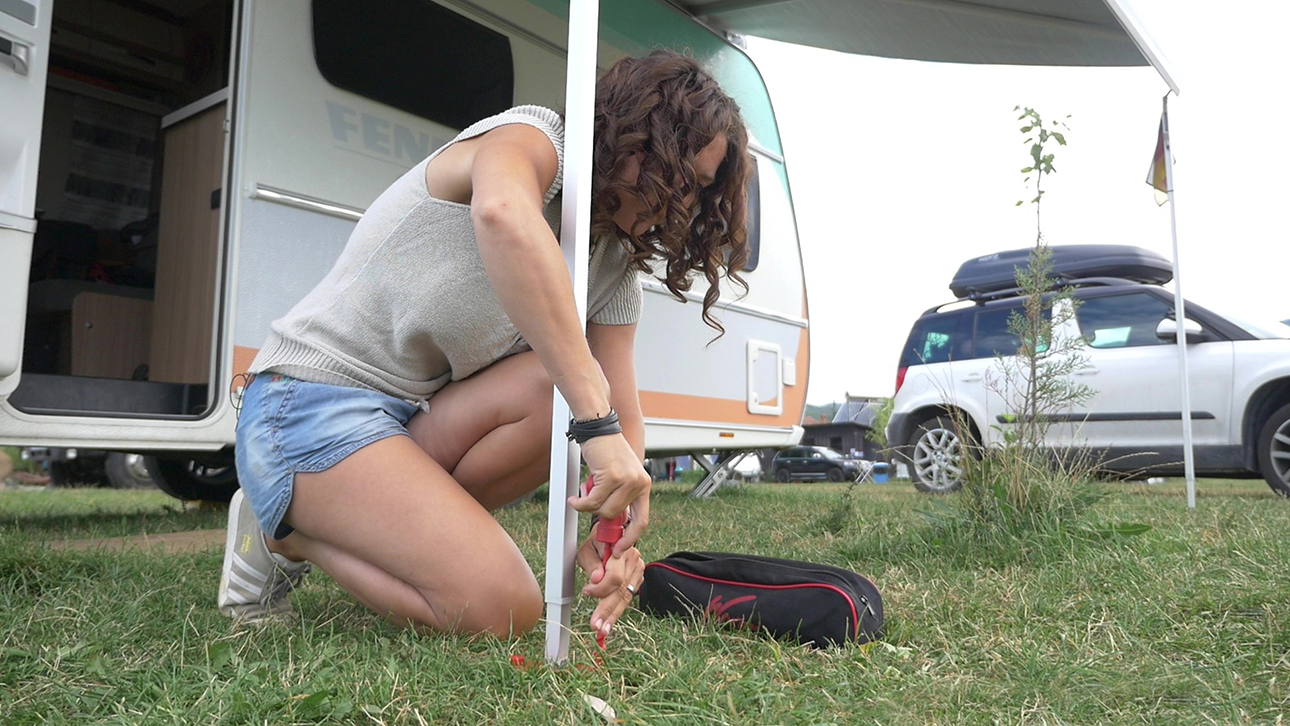
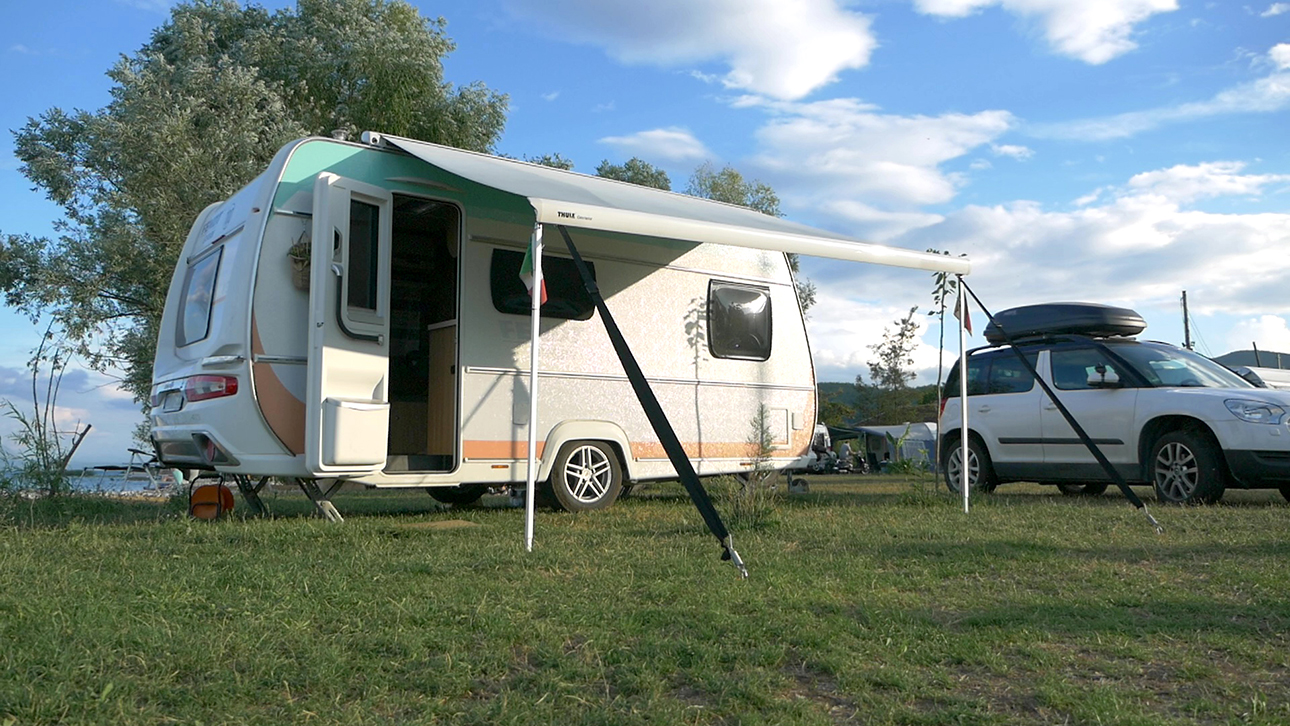
For awnings with side walls, I would recommend taking them down as a precaution and stowing them in the camper if strong winds are forecast or if you are leaving the pitch for a longer period of time. But there is also the option of using storm straps. It is also advisable to use guy ropes to ensure that everything is really taut.
Free-floating awnings are the most sensitive to wind; however, they usually have a wind sensor that retracts them automatically.
Not all herring are the same
For anchoring the storm straps to the ground, the simple universal pegs that are usually included as basic accessories when purchasing an awning or sunblind are generally not the best choice.
You’re probably familiar with this: on hard surfaces, it can be really hard work to get them into the ground. Nothing works without a rubber mallet and once they’re in, it’s hard to get them out again. They are then often bent as well. On soft floors, on the other hand, they come loose just as quickly as you drove them in. A small gust of wind is often all it takes.
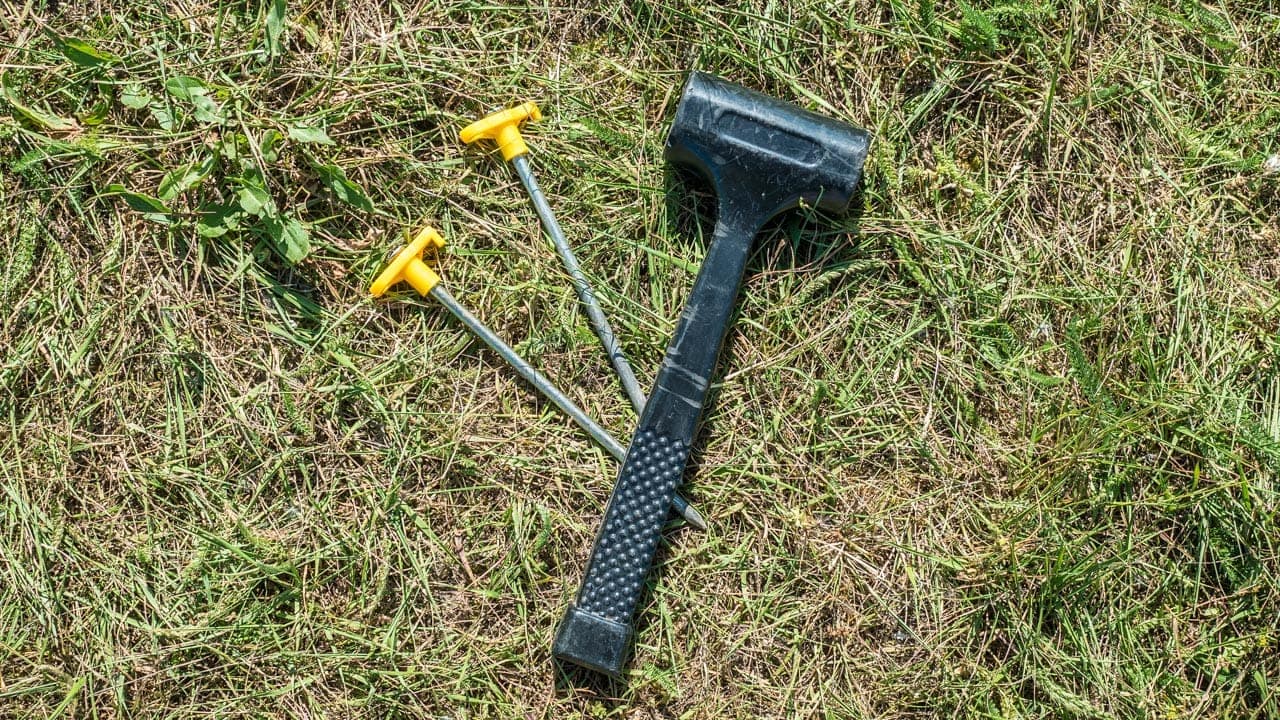
So-called V-pegs or Y-pegs are better here – wider V- or Y-profiles that offer significantly more grip. They are available in different sizes and materials, adapted to the surface on which they are to be used.
I myself use the third and, in my opinion, best option, namely screw pegs. Here, too, you can choose between different materials and sizes. A real advantage: they are available in signal colors! This makes it much easier to find them when dismantling.
- Camping Schraubheringe STARTERSET – Wurmi – STABIELO – inkl TASCHE…
- Unser neues Starterset Vorzelt 2014 ist mit neuen Hakenclip ausgestattet für Trekking und Standard
Screw pegs have hexagonal heads and you can screw them into softer floors by hand using a screw adapter. For hard floors, a cordless screwdriver or ratchet will help. Many manufacturers also supply the appropriate attachment for the screwdriver. If the floor is very hard, you can also use the cordless screwdriver to pre-drill the holes. This makes it easier to screw in the pegs afterwards.
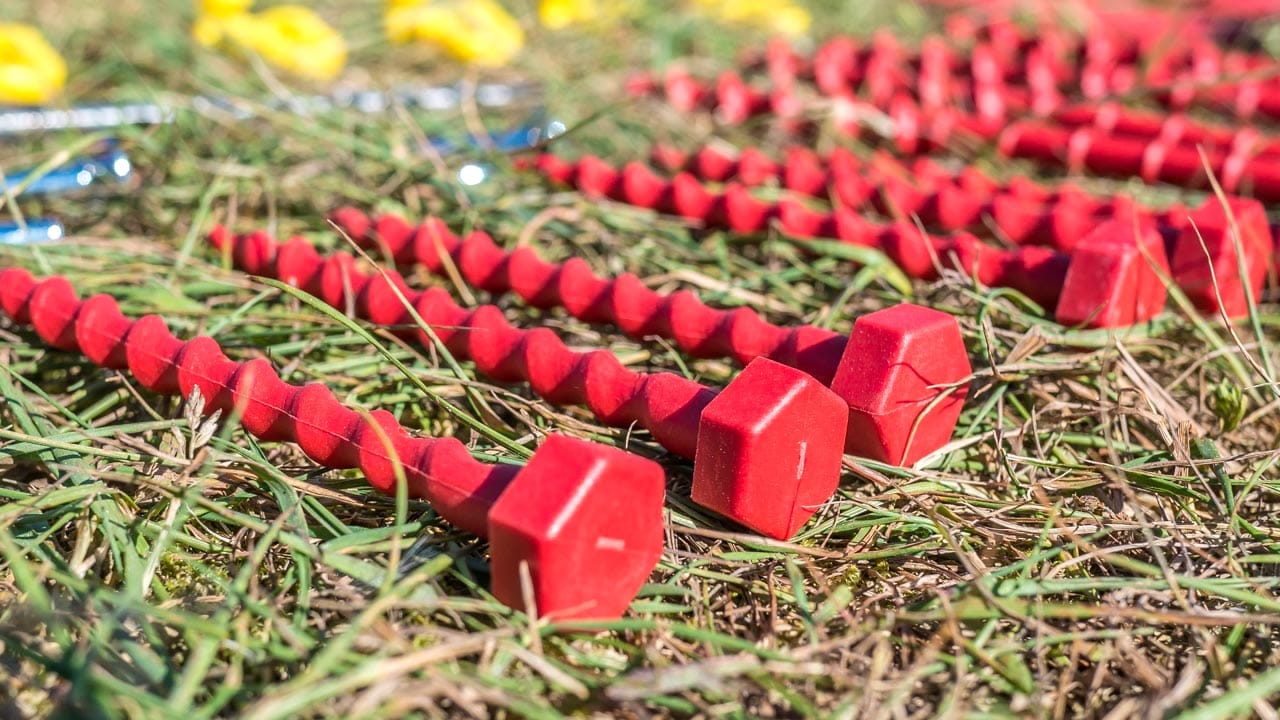
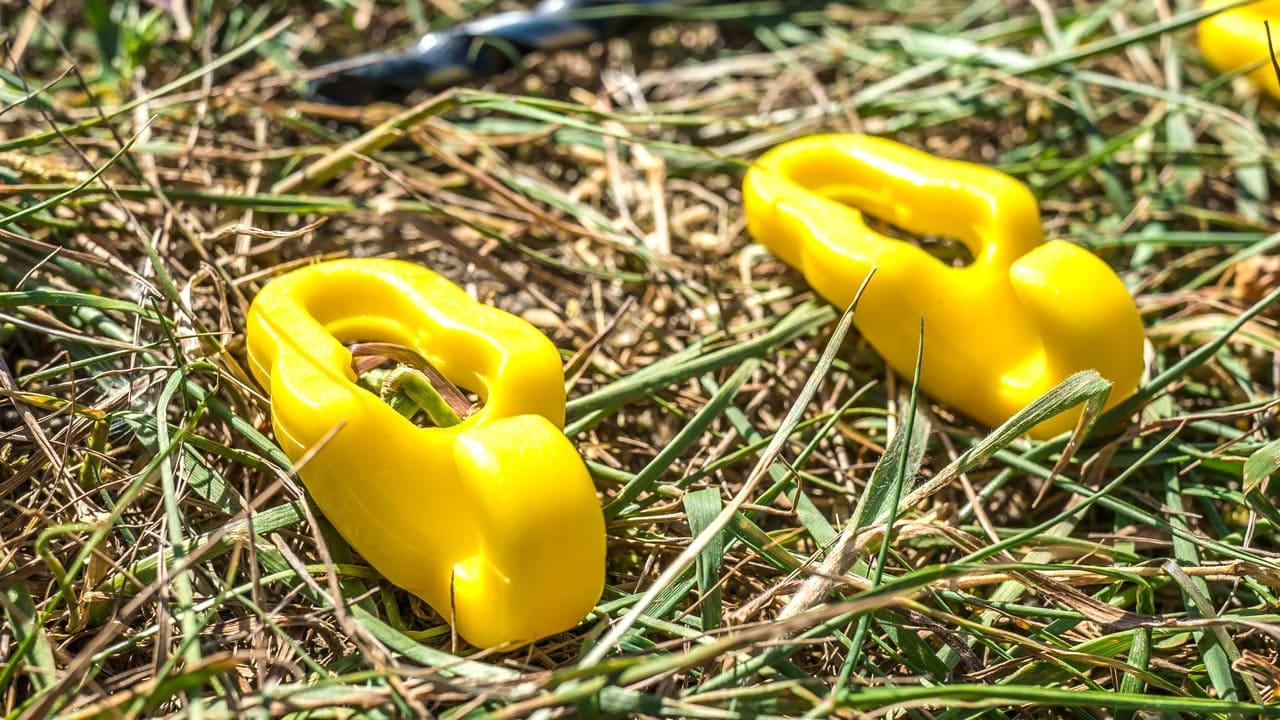
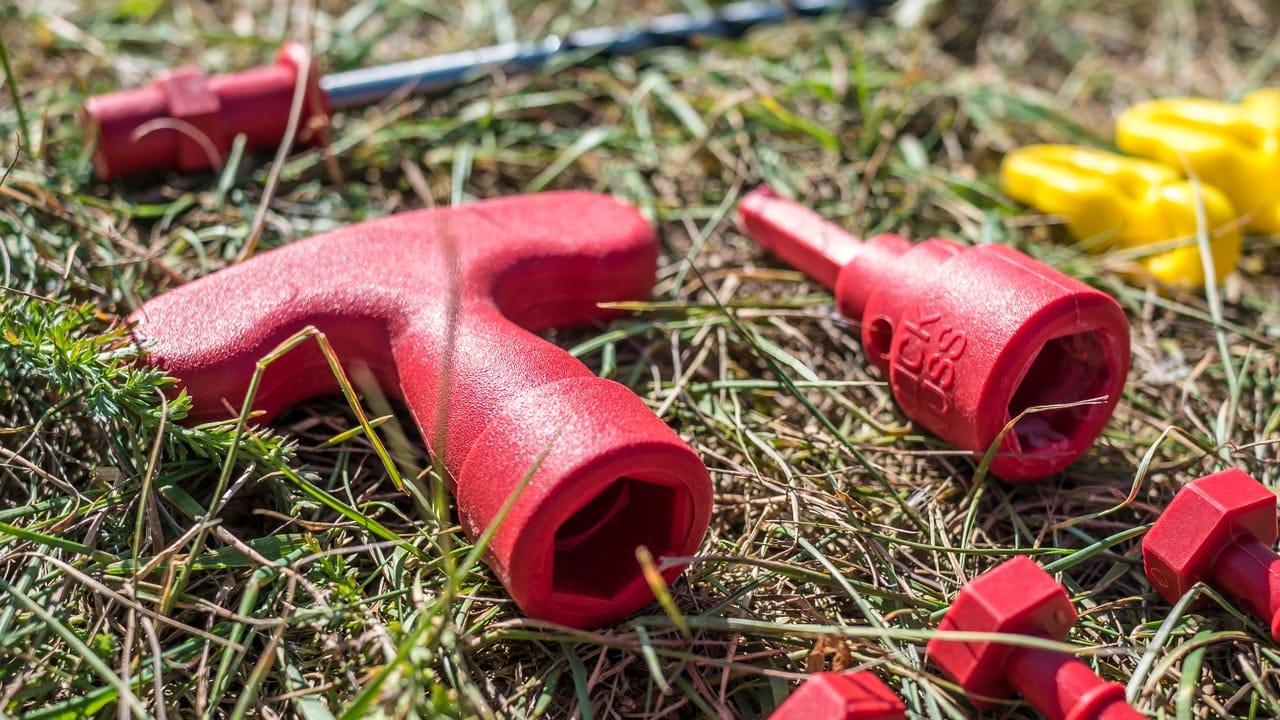
Matching anchor plates, with which the tent or awning base can be additionally secured, help to give the whole thing even more stability. Some manufacturers offer sets that are specially put together for awnings or tents depending on the equipment – in addition to the various pegs, they also include matching hook clips, the screw adapter and a matching bag.
“Depending on the ground conditions, it is not always necessary to screw the pegs in completely. However, it is important that the thread of the screw peg sits completely in the ground! In this case, the clips for tensioning do not have to be attached to the top of the screw peg, but fixed close to the ground. This prevents unwanted leverage and the storm hooks remain in place. For softer ground, I recommend using longer screw pegs – here, too, it is usually possible to tie off close to the ground using the accessories supplied.”
Tobias Göhre, Junior Managing Director at screwdriver herring manufacturer Wurmi
In the CamperStyle team, the storm straps from the Thule Hold Down Side Strap Kit are used in combination with the screw-on awnings and panels from the Wurmi awning set – so far successfully and without storm damage! 🙂
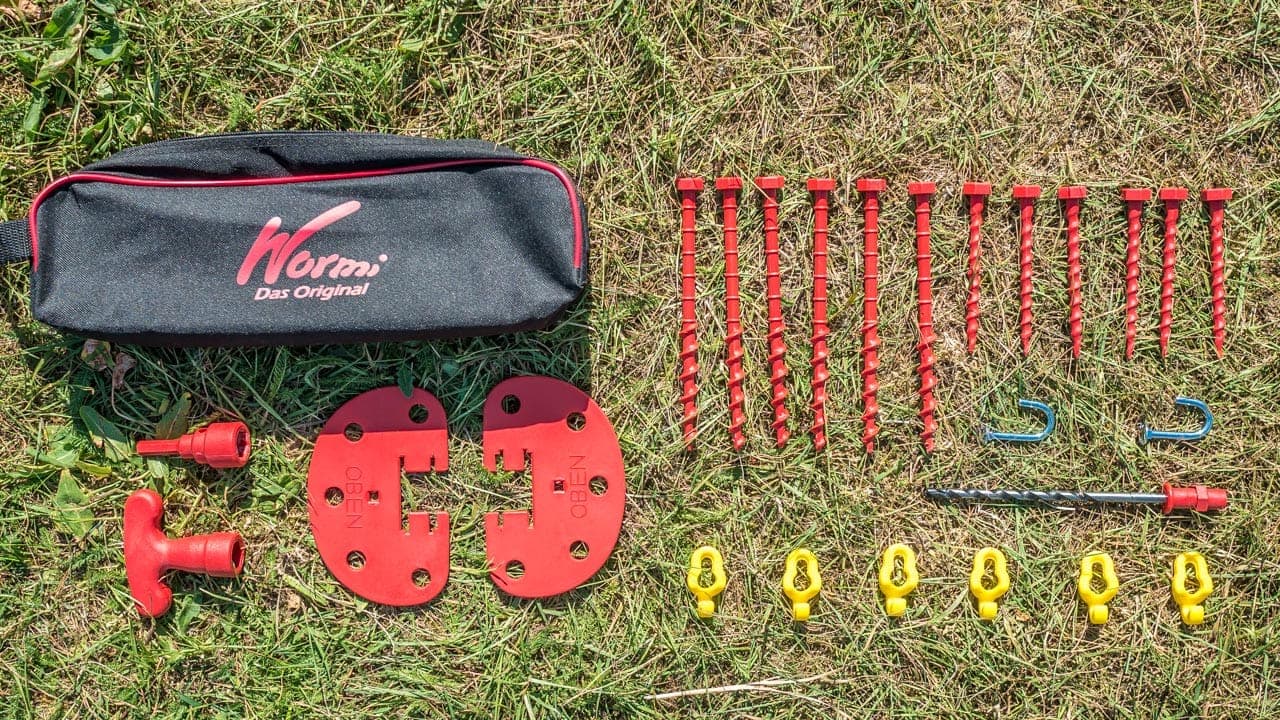
Safety first
So what should you do if you want to leave your awning or tent out overnight or for a longer period of time? Always check the weather forecast – that helps a lot. I remember too well one night in the Camargue when the notorious mistral suddenly and just as violently blew up and we had to gather our partly destroyed equipment from the surrounding bushes in the middle of the night. Convenience can be really expensive here.
That’s why I would always secure the awning and awning well with the right accessories. It is difficult to give a general recommendation as to the wind force at which you should take down your awning, as this depends very much on the individual weather conditions and wind currents. There are also different recommendations for awnings, depending on the manufacturer.
In case of doubt, however, safety always comes first! This means that if there is a thunderstorm or storm warning, it is better to retract the awning in good time. After all, it is the part with the least resistance and it can otherwise happen that the frame stands thanks to the storm strap, but the fabric hangs in tatters.
With an awning, the load is spread over several points, but here too, dismantling is the more complicated but better solution in a real storm. You want to be able to sleep in peace even in wind and weather!
Avoid tripping hazards
The mostly black storm bands are often difficult to recognize, especially at night or by people with visual impairments. To prevent yourself or one of your neighbors from tripping over them, you should mark them somehow, for example with orange or yellow flags. Alternatively, you can of course also apply self-adhesive reflective tape or choose items in a warning color.
Tool and accessory tips
Of course, you can borrow the necessary equipment from your neighbors in an emergency, but hand on heart: every camper van should have a decent set of tools. Here is a list of what you should have with you for your work around the awning and sunblind:
- Various screwdrivers (slotted and Phillips)
- Rubber mallet and pulling aid for pegs
- Cordless screwdriver, universal drill bit set and screw adapter for screw pegs
- Ratchet box
- a brush for cleaning the piping rail
- Hand brush and shovel
- Armored tape, cable ties and seam sealant
A step or small ladder is also helpful for fitting the awning or sunblind.
- 🔒 𝐒𝐈𝐂𝐇𝐄𝐑 & 𝐒𝐓𝐀𝐁𝐈𝐋: Unser klappbarer Tritthocker wurde…
- 👍 𝐏𝐋𝐀𝐓𝐙𝐒𝐏𝐀𝐑𝐄𝐍𝐃 & 𝐋𝐄𝐈𝐂𝐇𝐓: Mit nur 1,56 kg…
I hope these tips have helped you and wish you a storm- and hail-free camping summer!
Photos: © CamperStyle
Letzte Aktualisierung der Preise am 2026-01-09 / Affiliate Links / Bilder von der Amazon Product Advertising API
